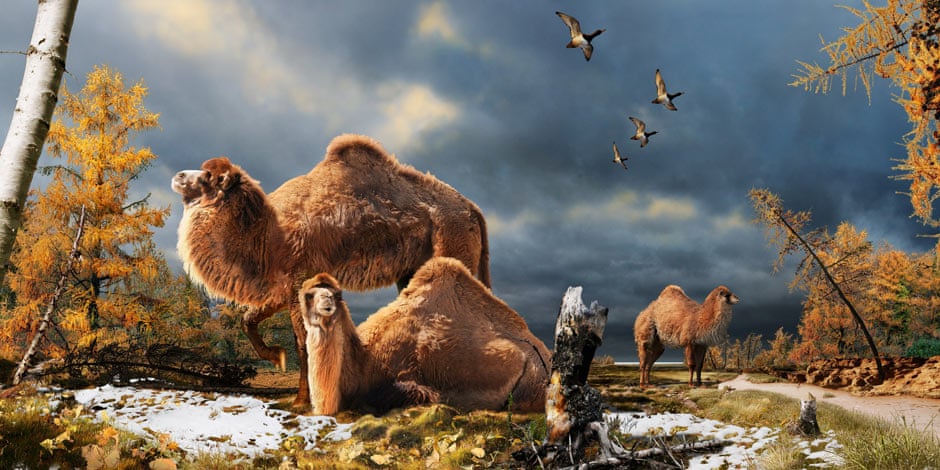 |
Giant Arctic camels (Artist's impression) Image credit: Julius Csotonyi PR |
Modern camels come in two species - the one-humped dromedary or Arabian camel (Camelus dromedarius) and the two-humped Bactrian camel (Camelus bactrianus). Although both exist in their wild forms in central Asia, they are normally seen as the domesticated beasts of burden in Arabia and the Horn of Africa. Their closest relatives are the South American guanaco (Lama glama) (domesticated as the llama) and vicuña (Vicugna vicugna) (domesticated as the alpaca).
So how did these related species come to be so widely distributed and in disconnected landmasses?
The answer has now been found using the relatively new science of collagen fingerprinting, which has also very recently solved another problem related to the South American ungulates, about which I wrote only yesterday. Basically, collagen is a highly stable structural protein that can sometimes be recovered from fossils even when DNA has degraded too far to be useful. When analysed for amino acid sequence and the results compared to other living animals, the resulting cladistic diagram shows the evolutionary relationships between them.
Using this technique, a team led by Dr Natalia Rybczynski of the Department of Palaeobiology, Canadian Museum of Nature in Ottawa, Ontario, has shown that a species of giant camel, known from fossil remains found on Ellesmere Island inside the Arctic Circle, were closely related to modern Asian camels and were very probably ancestral to them.
The camel family are believed to have originated in North America from a stem species about the size of a rabbit. The family then diverged into the Camelini and the Lamini, the later migrating to South America when the Panama isthmus formed, and the former migrating north, becoming adapted to living on snow, before migrating via Beringia to Asia. Beringia formed in the area now forming the Bering Strait between Alaska and Siberia, when sea-levels were lower due to continental glaciation, and the climate was locally warmer. This lowering of sea levels to expose Beringia probably happened several times over several millions of years, allowing North American and Asian mammals to move from one landmass to another, including humans.
The giant camels from the Yukon were all believed to be Paracamelus, the ancestor of the Euro-Asian camels, and the evidence presented in this paper suggests that the Ellesmere Island giant camels were the same, or a very closely related, species. These camels would have endured a sunless winter when temperatures were well below zero for several months, although temperatures were higher then than now and the area would have supported an arboreal biota consisting of larch forests.
It is this adaptation to living on snow which makes the Asian camels also able to live on the fine desert sands of Arabia and North Africa. Being able to close their nostrils to keep out blowing snow, they were also able to do the same to keep out blowing sand, and being able to spread their weight with a broad foot to be able to walk on snow, so they can do the same on sand. And being able to store and conserve water in long periods of sub-zero temperature, they can do so in deserts between oases. This adaptation would also have enabled them to survive the last Ice Age in Asia.
It's beginning to look like this new technique of collagen fingerprinting is yielding lots of answers that must be making creationists wince. Stand by for a concerted campaign of misinformation to discredit it, mixed with jubilation if something revealed by it can be misrepresented to make it looks as though the discovery supports creationism. Just imagine having to try to fit 3.4 million year-old camel remains into a story which claims Earth is only 6,000 years old because that's what your favourite story book says and you're too afraid to disagree in case a magic invisible sky bogeyman gets you. It can't be easy for them.
'via Blog this'

No comments:
Post a Comment
Obscene, threatening or obnoxious messages, preaching, abuse and spam will be removed, as will anything by known Internet trolls and stalkers, by known sock-puppet accounts and anything not connected with the post,
A claim made without evidence can be dismissed without evidence. Remember: your opinion is not an established fact unless corroborated.